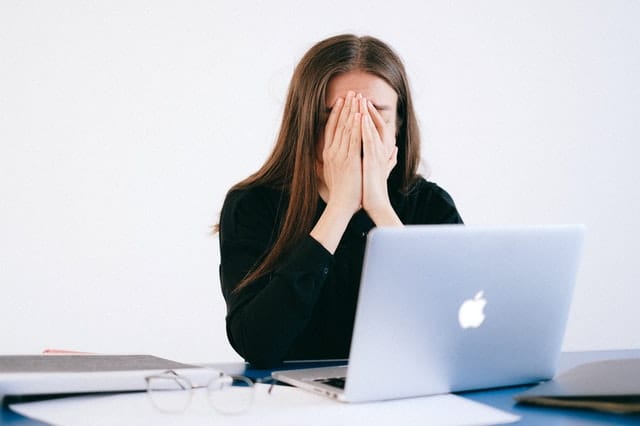How to Calm Anxiety – A Comprehensive Approach
Whether it is about a job interview or an important test, it is safe to say that everyone has experienced anxiety at some point in their life.
In fact, it is a vital part of our survival because it alerts us to potential threats and motivates us to face difficult challenges.
It does this by activating the stress response of our autonomic nervous system (sympathetic response), also known as the” fight or flight” mode, as opposed to the “rest and digest” mode (parasympathetic response).
However, anxiety can also work against us. For some people, anxiety is more than a temporary or mild sensation.
It can also present as a persistent and disproportionate mental and physical response to a perceived “threat” that has a debilitating impact on daily life.
This is usually the case in several anxiety disorders (e.g. Generalized Anxiety Disorder, Social Anxiety Disorder, Panic Disorder).
Common signs and symptoms of anxiety include increased heart rate, muscle tension, perspiration, restlessness, fatigue, difficulty controlling worry, trouble concentrating, and/or a sense of doom or danger.
The management of anxiety is complex and will depend on the type of disorder. In general, most patients benefit from a combination of psychotherapy (Cognitive Behavioral Therapy) and/or anti-anxiety medications (1).
However, it is up to a licensed health professional to determine the best approach for the needs of each patient.
What we know for sure is that, as a person with anxiety, you need two things to find relief: a long-term plan that will prevent the anxiety from becoming more persistent and skills that can help you cope when it finally appears.
How to calm anxiety: The Long-Term Plan
Cognitive Behavioral Therapy (CBT) is the leading treatment for anxiety disorder, given that it can be effective after as little as eight sessions (2).
It is usually short-term, focused on the present, and goal-oriented. This is a great place to start when looking for a long-term plan to manage anxiety.
Typically, the first thing a CBT therapist will do is educate the patient about their problem (e.g., common symptoms or possible treatments).
Then, one common approach is Cognitive Therapy, where the therapist will attempt to help the patient identify and understand irrational or negative patterns of thought/behavior that are associated with anxiety.
Once detected, the goal is to work with the patient to challenge these beliefs/behaviors and replace them with realistic or less negative ones (3).
Another approach is Exposure, which is more or less what it sounds like: repeatedly facing situations that cause you anxiety in a controlled environment. In essence, these are just a few examples of the skills and treatments CBT has to offer.
How to Calm Anxiety Fast – Coping Skills
Has anyone ever told you to “just relax!” when you are feeling anxious? The odds are that it wasn’t helpful. If you suffer from an anxiety disorder, you probably know that “relaxing” is easier said than done.
The good news is that coping skills-including relaxation techniques are widely used and taught in CBT (4). Their goal is to help patients moderate the fight-or-flight response that is triggered in these disorders.
For instance, they can temporarily help decrease your heart rate, reduce muscle tension, and improve problem-solving skills. Importantly, these techniques are not meant to treat the source of the problem or stop anxiety immediately.
Instead, they should be used to prevent or cope with the signs and symptoms of anxiety. Possible coping skills or relaxation techniques include diaphragmatic breathing, progressive muscle relaxation, guided imagery, mindfulness (5), and grounding techniques.
When considering the use of coping skills for anxiety, remember that they are only a small part of a comprehensive treatment program.
Additionally, for some people, coping skills can have the opposite effect (6). Thus, it is important to work with a mental health professional to find the best approach for you.
1. Breathing
Diaphragmatic breathing is a fundamental coping skill that can help manage anxiety (7). It is easy but effective and it’s also discreet so you can use it at any time or place.
Moreover, it is often taught in CBT as a daily practice (e.g., twice daily) that can help with anxiety coping and prevention.
Diaphragmatic breathing (also known as abdominal breathing) involves the correct use of the diaphragm, rather than the chest, for deep breathing.
This dome-shaped muscle is located at the base of the lungs, and when it moves downward (inhalation), it increases the space in the chest for the lungs to expand. Conversely, the diaphragm relaxes during exhalation, moving upward.
That said, you can probably deduce that during deep breathing -as opposed to shallow breathing- the lungs can expand correctly and oxygen exchange is increased. As a result, your heart rate might slow down during this practice.
Using this muscle properly can also trigger the vagus nerve, which can help the body’s calming relaxation response (parasympathetic response) prevail over the “fight or flight” response (7). For instance, it can also help decrease your heart rate and reduce muscle tension.
First, to practice this technique, find a quiet and comfortable place to sit and place one hand on your stomach. Secondly, bring your full attention to your breath and close your eyes.
Then, breathe in deeply through your nostrils (4s) so the hand on your abdomen rises. Finally, hold the air in (4s) and exhale through your mouth (6s).
This exhalation must be slow and your lips should be in the same position you use to blow through a straw. Repeat for 3-5 minutes.
2. Progressive Muscle Relaxation (PMR)
Muscle tension is an important part of the body’s fight-or-flight response. If you suffer from persistent anxiety, it is likely that you are constantly tense during the day and rarely recognize what muscle relaxation feels like.
Progressive Muscle Relaxation (PMR) is a CBT technique that can help you learn the difference between those two states (8). This is important because, with practice, you will be able to spot and offset the first signs of anxiety-related muscle tension while cueing a sense of relaxation in your body.
PMR is based on the fact that it is almost impossible to feel anxious if our muscles are completely relaxed since the calming response in our body (parasympathetic response) is already predominant.
Thus, it involves a set of exercises that focus on the sequential tensing and relaxing of the major muscle groups. For instance, it can involve several body parts like the feet, calves, shoulders, hands, face, etc. (9)
A great way to practice PMR on your own is by using an audio recording, mostly until you learn the technique. You will need to set aside roughly 15 minutes to complete it.
Most exercises will start with your feet, instructing you to curl your toes tightly for 30 seconds and then to release them slowly.
Then, they will progressively move upwards in the same manner. Recall that it is important to practice this exercise when you are feeling calm (e.g. twice daily), so you can elicit a relaxation response quickly when you need it.
3. Guided Imagery
If CBT has taught us something is that thoughts can change how we feel. For instance, when we imagine something or somewhere calming we tend to feel more relaxed.
Guided imagery is a technique that can be used in CBT, in which individuals focus on mental representations (10). It can have several purposes (e.g., visualization of positive outcomes), but it can also work as an effective relaxation technique for anxiety.
When Guided Imagery is used for this purpose, the therapist often encourages the patient to envision a peaceful space with as many sensory details as possible.
For example, you might be asked to focus on a place that you find comforting (e.g., a beach, or mountaintop) with all its aromas, sounds, and textures. For this to work, you have to REALLY imagine it (5-10 minutes): thinking about it fleetingly does not work.
Seeking the help of a therapist for this technique is recommended to obtain all the benefits of the intervention. Once learned, it can also be used independently to cope with anxiety.
For this, you can find several guided imagery scripts or audio recordings online. Finally, you can also use a recording of a personal script that works for you.
4. Grounding Techniques
Grounding techniques are skills that can be used to cope with symptoms of trauma disorders (11) (e.g., post-traumatic stress disorder or PTSD), as well as anxiety disorders.
In these conditions, intrusive thoughts, worries or memories can make us lose touch with our reality.
Grounding techniques can temporarily help us concentrate on being in the present moment by turning our attention away from these difficult emotions.
To connect us to the present, some of these skills make us focus on our five senses.
For instance, to practice the “5-4-3-2-1 Technique”, ask yourself the following questions while trying to notice most of the details of your surroundings.
- What are 5 things you can see?
- What are 4 things you can feel?
- What are 3 things you can hear?
- What are 2 things you can smell?
- What is 1 thing you can taste?
Other grounding methods include mental exercises (e.g., counting or reading backward) or body awareness techniques (e.g., stomping your feet or rubbing your palms together).
Also, any method that you create for yourself is valid.
Disclaimer
The purpose of this article is entirely educational. This information is not supposed to replace the medical assessment and should not be considered as medical advice.
You should always consult a doctor before taking any supplements and/or medications.
References:
Bandelow, B., Michaelis, S., & Wedekind, D. (2017). Treatment of anxiety disorders. Dialogues in clinical neuroscience, 19(2), 93–107. https://doi.org/10.31887/
Stewart, R. E., & Chambless, D. L. (2009). Cognitive-behavioral therapy for adult anxiety disorders in clinical practice: A meta-analysis of effectiveness studies. Journal of Consulting and Clinical Psychology, 77(4), 595–606. https://doi.org/10.1037/a0016032
Hans, E., & Hiller, W. (2013). A meta-analysis of nonrandomized effectiveness studies on outpatient cognitive behavioral therapy for adult anxiety disorders. Clinical Psychology Review, 33(8), 954–964. https://doi.org/10.1016/
Manzoni, G. M., Pagnini, F., Castelnuovo, G., & Molinari, E. (2008). Relaxation training for anxiety: a ten-year systematic review with meta-analysis. BMC Psychiatry, 8(1). https://doi.org/
Liu, X., Yi, P., Ma, L., Liu, W., Deng, W., Yang, X., Liang, M., Luo, J., Li, N., & Li, X. (2021). Mindfulness-based interventions for a social anxiety disorder: A systematic review and meta-analysis. Psychiatry Research, 300, 113935. https://doi.org/10.1016/
Kim, H., & Newman, M. G. (2019). The paradox of relaxation training: Relaxation induced anxiety and mediation effects of negative contrast sensitivity in generalized anxiety disorder and major depressive disorder. Journal of Affective Disorders, 259, 271–278. https://doi.org/10.1016/
Chen, Y.-F., Huang, X.-Y., Chien, C.-H., & Cheng, J.-F. (2016). The Effectiveness of Diaphragmatic Breathing Relaxation Training for Reducing Anxiety. Perspectives in Psychiatric Care, 53(4), 329–336. https://doi.org/10.1111/
Conrad, A., & Roth, W. T. (2007). Muscle relaxation therapy for anxiety disorders: It works but how? Journal of Anxiety Disorders, 21(3), 243–264. https://doi.org/10.1016/j.janxdis.2006.08.001
Jacobson, E. (1938). Progressive relaxation(2nd ed.). Univ. Chicago Press.
Hirsch, C. R., & Holmes, E. A. (2007). Mental imagery in anxiety disorders. Psychiatry, 6(4), 161–165. https://doi.org/10.1016/j.mppsy.2007.01.005
Williams, M. B., & Poijula, S. (2016). The Ptsd workbook: simple, effective techniques for overcoming traumatic stress symptoms. New Harbinger Publications, Inc.
See Also
Foods That Cause Anxiety and Panic Attacks

Dr. Mera focuses on the use of evidence-based medicine for the care of his patients.
He is an experienced medical writer with over 60 articles available online. Accredited by the AHA (American Heart Association) as a Certified Provider in Advanced Cardiac Life Support.
